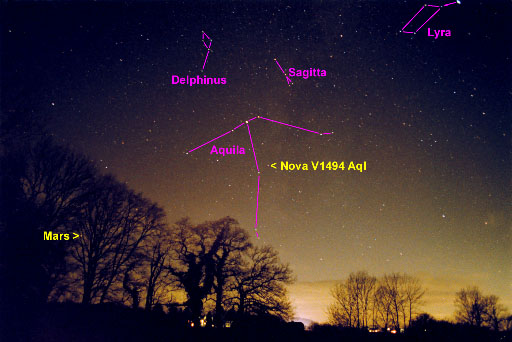

Nova V1494 Aquilae

labels on/off
| Date: | 04.12.99 |
Time: | 17:40 UT |
Exposure: | 45 s |
| Field of View: | 73o x 53o |
Emulsion: | Kodak Royal 1000 Select |
Filter: | none |
| Optics: | f=24mm 1/2.8 |
Place: | Lippstadt |
Observer: | T. Credner |
|
|
Notes to the data
|
© Copyright by the observers
On December the 1st 1999 a Nova was found by the portuguese amateur
astronomer Alfredo Pereira
(IAU Circular 7323).
This new appearing star had a brightness of 6 mag
and increased up to about 3.9 mag at 3rd of December. Thus it became quite
easily visible to the naked eye. The above photography from the 4th shows
the Nova in the
constellation of Aquila
with a brightness of about 4.7 mag.
This star is of course not really new, a predecessor could be found on Palomar
Schmidt plates with a brightness of about 16 mag. It means that the star intensity
increased by a factor of 70.000 !
A Nova originates from an interacting binary star. A compact and dense white
dwarf can accrete mass by its close companion, a normal main sequence star.
The companion has such a critical large radius and small distance to the dwarf
that mass can flow to the white dwarf and builds up an accretion disc around it.
The disc material looses energy due to friction, spirals inward and rains
onto the dwarfs surface. If this hydrogen rich material reaches a critical
mass on the white dwarfs surface a nuclear hydrogen burning starts
explosively. This gives the outburst in luminosity and the often
observed expanding shells in Novae and their
remnants.

